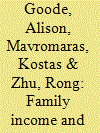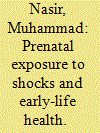|
|
|
Sort Order |
|
|
|
Items / Page
|
|
|
|
|
|
|
| Srl | Item |
| 1 |
ID:
133194


|
|
|
|
|
| Publication |
2014.
|
| Summary/Abstract |
We examine the effect of family income on child health using data from the China Health and Nutrition Survey. We find a significant child health/family income gradient for the overall sample of Chinese children. Our preferred specification shows that the income gradient increases with child age until the age of 12. We find that parental health consciousness, household sanitation conditions and nutrition intake are the channels through which family income affects child health. After controlling for these transmission channels, the gradient strengthens with child age until the age of 17. We find that children from poorer families in China are not only more likely to experience several types of chronic illnesses, but also less likely to address effectively some health conditions. The income gradient is found to be very heterogeneous, with greater effect on children with poorer health, girls and children in rural China.
|
|
|
|
|
|
|
|
|
|
|
|
|
|
|
|
| 2 |
ID:
190838


|
|
|
|
|
| Summary/Abstract |
This article evaluates the extent to which armed conflicts influence early childhood health for 56 developing countries over nearly 30 years. Exploiting both spatial and temporal variations in conflict exposure within a difference-in-differences framework, the article uncovers detrimental ramifications of armed conflicts on the health outcomes of children under five years old. Particularly, children exposed to armed conflicts have lower height-for-age, weight-for-height, and weight-for-age z-scores by 0.08, 0.05, and 0.10 standard deviations, respectively. Taking the average corresponding anthropometric z-scores of unexposed children as the benchmarks, exposure to armed conflicts makes children 6.6% shorter for their age, 11% thinner for their height, and 9% thinner for their age. Exposure to armed conflicts further makes children 2.2, 0.8, and 2.6 percentage points more likely to be stunted, wasted, and underweight, respectively (i.e. 7.3%, 7.9%, and 10.2% increases compared to the benchmark averages of those unexposed to armed conflicts). In addition, the heterogeneity analyses suggest that children born to low-education mothers, children from relatively poor households, and children living in rural areas tend to bear the larger health setbacks. Given the long-lasting impacts of poor health in early childhood on adult outcomes, delivering nutrition interventions to children in conflict zones is of utmost importance, and extra attention should be given to children of disadvantaged backgrounds.
|
|
|
|
|
|
|
|
|
|
|
|
|
|
|
|
| 3 |
ID:
179958


|
|
|
|
|
| Summary/Abstract |
Simultaneous exposure to natural calamities and conflict shocks is a phenomenon that has been largely understudied. The interplay between natural disasters and conflict shocks can have adverse effects extending beyond the current family members to children in utero. The current paper tries to fill this gap by investigating the impact of floods on pregnancy and birth outcomes across conflict-affected and unaffected districts in Pakistan. Using mother fixed effects strategy, the results suggest that in-utero exposure to violence during flood increases the probability of small birth size by 4.7 percentage points. Moreover, simultaneous exposure to flood and violence increases the probability of miscarriages and stillbirths by 6 and 1.9 percentage points, respectively. Significant heterogeneities are found across income groups and education levels.
|
|
|
|
|
|
|
|
|
|
|
|
|
|
|
|
| 4 |
ID:
097328


|
|
|
|
|
|
|
|